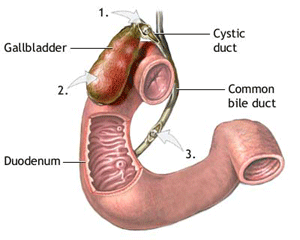What is gallstone disease?
 The gall bladder which is situated under the liver is a thin walled reservoir that stores bile. On an average, it stores about 40 to 50 ml of bile. For a normal healthy person, the liver secretes about 700 ml of bile each day. When the secreted bile is sufficient, then the excess bile is concentrated and is stored in the gall bladder.
The gall bladder which is situated under the liver is a thin walled reservoir that stores bile. On an average, it stores about 40 to 50 ml of bile. For a normal healthy person, the liver secretes about 700 ml of bile each day. When the secreted bile is sufficient, then the excess bile is concentrated and is stored in the gall bladder.
The composition of the bile includes 40% cholic acid, 40% chenodeoxycholic acid, 2% lithocoholic acid and 18% deoxycholic acid. The occurrence of gallstone is very high in western countries when compared to the Asian countries. These stones when occurring usually do not show any symptom.
There are different types of gallstones. The biliary sludge occurs as a result of complicated intravenous feeding. The cause of this is due to the fact that the gall bladder does not contract in the absence of fat in the feeds. This process ultimately leads to the stagnation of the bile, then leading to precipitation of the sludge and hence to the formation of gallstone. The gallstones formed in the gall bladder may also contain bile pigments and calcium carbonate.
At times a pure stone of cholesterol can also occur. In normal conditions, the cholesterol, bile salts and other phospholiquids help in keeping the bile in liquid state. When the cholesterol precipitates in the bile, then gallstones are formed.
The precipitation of the cholesterol can occur due to the following reasons. The cholesterol precipitation can occur due to the increased concentration of cholesterol. In patients with the gallstone, the liver produces super saturated bile and the high calorie intake leads to further favors gallstones. The decreased concentration of the bile salts and phospholiquids can also lead to the gallstone formation.
Dietetic management for gallstone bladder
The gallstone usually occurs when there is a large intake of calorie in proportion of their protein intake. Therefore, minimum amounts of calorie should be taken in order to maintain a good health. Diets that are protein rich can also increase the concentration of the biliary cholesterol. For a normal diet, 60 to 80 g of proteins is sufficient.
The fats can be consumed as normal and should not be stopped mistakenly. There is no evidence that a low fat diet has any effect on the gallstone treatment and hence should not be avoided. The Chinese foods like fried rice and fried noodles should be avoided completely if they produce any discomfort. In most cases the diet is provided in such a way that the patient receives the normal amount of calorie with proportion to the proteins. Vitamins and other nutrients can be administered in the form of supplements.